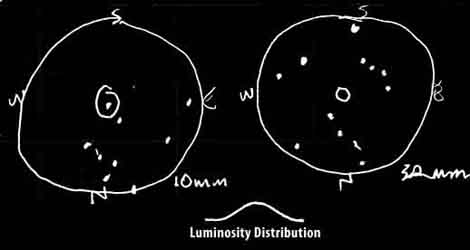
Observation Notes:
This is one of 3 globular clusters I observed at the base of the Sagittaruis teapot on 10/3/04. (The others were M69 and M54. M70 appeared as a small globular cluster with a soft distribution of luminosity, with a distinct but soft core. The 120X view seemed to show one resolved star dead center. The E edge seemed to have a sharper drop-off in brightness than the rest. The low power 37X view showed a line of 4 stars to the SSE.
Factoids:
Slightly larger and slightly brighter than its neighbor M69, M70 is about the same distance--29,300 light years--and is 68 light years in diameter. The core of M70 is extremely dense and is noted to have undergone a core collapse at some point in its history. It is moving away from us at the rapid clip of 200 km/sec. Charles Messier described it in 1780 as a "nebula without star." William Herschel was the first to resolve the cluster into stars and described it as "a miniature of M3". Comet Hale-Bopp was discovered near M70 in 1995 as Alan Hale and Thomas Bopp were observing the cluster.
| Subject | M70/NGC 6681 |
| Classification | Globular Cluster |
| Position | Sagittarius [RA: 18:43.2 / Dec: -32:18]* |
| Size* | 8' |
| Brightness* | 7.9 |
| Date/Time | 10/3/04 - 8:40 PM |
| Observing Loc. | Flagstaff, AZ - Home |
| Instrument | Orion SVP 6LT Reflector (150 mm dia./1200 mm F/L) |
| Eyepieces/Mag. | 32 mm (37X); 10 mm (120X) |
| Seeing | 5/10 |
| Transparency | Mag 4.5 |
* Based on published data.




